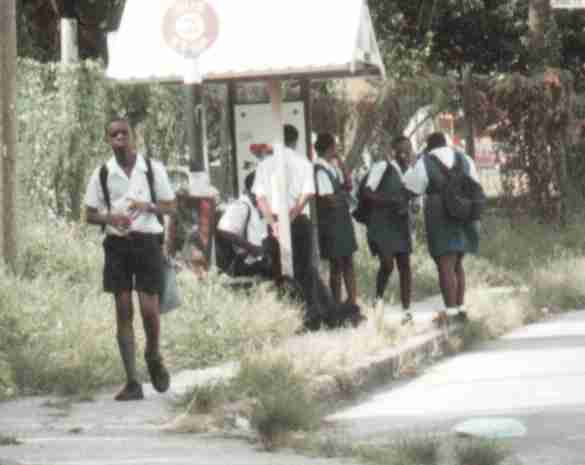
Figure 1.--Unlike some Caribbean islands, some school boys in Barbados continue to wear short pants and kneesocks. |

|
Barbados is the most easterly of the Catibbean islands, ctually located outsude the Caribbean. Barbados was the first British colony in the Caribbean and is one of the more traditional former British colonies in the Caribbean. And this is reflected in the country's school uniforms. Unlike many Caribbean islands, many boys continue to wear short pants school uniforms. Even some younger secondary-level boys wear shorts with knee socks.
Barbadian school uniforms have basically followed British styles. As in all the former British Caribbean colonies, all elementary-age boys and many younger secondary-age boys wore short pants. Knee socks were common. I'm not sure when styles began to differ from British styles. The major difference is blazers and ties are not work which of course because of the climate is a reasonable adjustment.
Neither boys nor girls wear ties with buttoned collars.
All Barbadian schools still appear to require uniforms. The principal of school uniforms on the former British colonies is widely accepted and Barbados is no exception. Uniforms have been retained in most of the former Bitish colonies, but the uniform standards seem especially strong in Barbados.
Girls uniforms are still basically British. All girls wear school frocks, jumpers, or skirts; shorts and pants are not worn. I did observe one secondary-age girl wearing trousers along with her uniform skirt. A reader tells us, "The girl wearing trousers under her skirt would have been Muslim. They are allowed to wear trousers and hijab for religious reasons." [Taitt] Many girls' uniforms had ties, but rarely worn with buttoned collars. Boys styles, unlike the girls' styles have changed. Barbados in 1999 still has some vestages of traditional school uniforms, but even in Barbados there have been major changes. Most schools have uniforms of white or colored shirts (blue, khaki, red, and yellow) and khaki or blue pants. As in other Caribbean countries, especially the former British colonies, khaki is a particularly popular color for school uniforms. One school has blue-grey pants. There are some schools who require rather traditional looking grey terelyn pants. Unlike the girls, ties were almost never worn by the boys, presumably because wearing them with open collars would look slopy while for the girls it looks fashionable. A reader reports in 2009. "Both genders usually wear short pants or overall (jumper) to age 14-15, then switch to long pants or skirt, sometimes with a change in shirt-colour also. At this time both genders begin wearing a tie, except for schools that extend beyond the minimum school-leaving age of 16. In this case students may wear epaulettes (shoulder badges) and only receive a tie for the pre-college forms (grades). Unlike girls, boy often remove their ties before and after school, this is why you would not have seen many secondary boys with ties. Ties on students are so institutionalised in our society that the lack of a buttoned collar is not seen as sloppy, I guess it seems strange when you are not used to it. Boys under 14 always wear short pants. The only exceptions are private schools. Schools no longer require hats for boy or girls, but many parents give their sons “baseball” caps to wear to and from school. Cub/Boy scouts also wear a cap with their scout uniform. Lower forms of secondary school require knee socks for boys, they are seen as unfashionable by the boys who usually don’t wear them pulled all the way up.
Epaulettes (shoulder badges) are used to identify the school as all-over khaki was once de rigueur for boys. They are required by almost all secondary schools for boys in the lower forms; for girls who have stopped wearing overalls (jumper) but not yet entered the pre-college forms; and by some primary schools for boys. A crest on the breast-pocket has now become quite popular at both primary and secondary level. Boys often remove them as they do with ties, but you are not considered properly dressed for school without epaulettes or tie. All schools require laced, leather/leather-look shoes for students. Sneakers are a big no-no except for PE. Some people will always try to do their own thing though." [Taitt]
|
Virtually all elementary-age boys wear shorts. One school had blur baseball-style caps. Khaki was a particulartly popular color for shorts, often worn with colored open collared shirts.
Many middle-school age boys and younger secondary-age boys also wear shorts. Khaki and blue shorts are the most common. Some boys wear kneesocks. Although ankle socks are the most common, several schools do require kneesocks. One school with blue-grey pants has blue-grey turn-over-top socks. Khaki turn-over-top socks are also worm. There are also several schools which have grey kneesocks and colored bands, including maroon and yellow/green bands. A number of schools have the boys wear military-style shoulder badges. I wasn't positive what the badges were. I thought they were some kind od symbol of rank. A HBC contributor suggests that as many schools use white shirts in Bridgetown, they are used to identify the specific school. This appears to be most common at secondary schools. Almost all boys wear leather shoes, almost always black, rather than sneakers.
Taitt, Shani. E-mail message, January 15, 2009.
Careful, clicking on these will exit you from the Boys' Historical Clothing web site, but several are highly recommended
Related Chronolgy Pages in the Boys' Historical Web Site
[Late 19th century]
[The 1930s]
[The 1940s]
[The 1930s]
[The 1940s]
[The 1950s]
[The 1960s]
[The 1970s]
[The 1980s]
Related Style Pages in the Boys' Historical Web Site
[Long pants suits]
[Knicker suits]
[Short pants suits]
[Socks]
[Eton suits]
[Jacket and trousers]
[Blazer]
[School sandals]
Navigate the Boys' Historical Clothing Web Page
[Return to the Main national school uniform page]
[Introduction]
[Activities]
[Biographies]
[Chronology]
[Cloth and textiles]
[Clothing styles]
[Countries]
[Topics]
[Bibliographies]
[Contributions]
[FAQs]
[Glossaries]
[Images]
[Links]
[Registration]
[Tools]
[Boys' Clothing Home]
